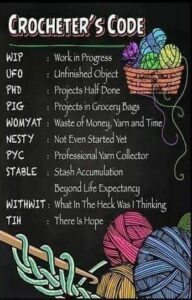Understanding the Jargon: UK vs US Knitting and Crochet Patterns
1. The Yarn Weight Predicament
In the UK, yarn weight categories are often described as 4-ply, double knitting (DK), Aran, and chunky. In contrast, the US uses both a descriptive and a numerical scale from 0 to 6.
For instance, DK (Double Knitting) yarn in the UK is considered a category 3 or Light Worsted yarn in the US.
conversion table yarn weights2. WPI stands for “Wraps Per Inch.”
WPI is a term used more predominantly in the USA, it is a measurement used in the textile industry to determine the thickness or weight of a yarn.
WPI is used more in the US than the UK and it is calculated by wrapping the yarn around a ruler and counting the number of wraps within an inch (2.5 cm). This measurement helps in determining the yarn weight category, which in turn can guide the appropriate choice of knitting needles or crochet hooks.
WPI is particularly useful if you are buying from a market or buying hand spun yarns. Of course, you may not have a ruler with you, but as a very rough guide, the top segment of your thumb is approx. an inch. (And it is approx. a yard/meter from your nose to your wrist – just in case you also happen to be buying fabric!)
3. Needles and Hook Sizes
Back in the ‘old’ days the UK had a numerical way of describing hook sizes, but then when the country converted to metric, hook sizes also changed to metric. So, in the UK there is the ‘old’ or traditional size, and the metric size. Countries such as Australia and Canada have traditionally followed the UK system.
In the US they didn’t change to metric but kept to their system, which includes both a letter and a number.
You will need to use a UK/US conversion chart to work out your hook or needle sizes.
wprd knitting needle sizes.hook sizes
4. Crochet Stitch Abbreviations
Crocheting is a hugely popular craft. But many people feel daunted by the task of learning to crochet. For those just stepping into the crochet world, they may encounter a perplexing challenge: the subtle yet significant differences in terminology between the United Kingdom and the United States.
Whatever the complexity of the pattern, these differences in terminology create an initial hurdle that the newbie must negotiate. This difference starts right at the initial ‘choosing a pattern’ stage.
5. Confusing Stitch Names
The trouble with the different names for common crochet stitches is that the names of the crochet stitches are very similar but they are worked differently. If you are working on a US crochet pattern and come across the term ‘double crochet’ it will mean something completely different to that found in a UK crochet pattern. You definitely need to know the country of origin for the pattern you are following before leaping into a project. You can probably find this by looking at the hook size, or the publisher address. In the table below you can see these differences.
crochet abbrev
And here are some more abbreviations you might like!

